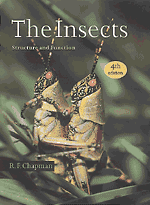Book contents
- Frontmatter
- Contents
- Preface
- Acknowledgments
- PART I The Head, Ingestion, Utilization and Distribution of Food
- 1 Head
- 2 Mouthparts and feeding
- 3 Alimentary canal, digestion and absorption
- 4 Nutrition
- 5 Circulatory system, blood and immune systems
- 6 Fat body
- PART II The Thorax and Locomotion
- PART III The Abdomen, Reproduction and Development
- PART IV The Integument, Gas Exchange and Homeostasis
- PART V Communication
- Taxonomic index
- Subject index
1 - Head
Published online by Cambridge University Press: 05 June 2012
- Frontmatter
- Contents
- Preface
- Acknowledgments
- PART I The Head, Ingestion, Utilization and Distribution of Food
- 1 Head
- 2 Mouthparts and feeding
- 3 Alimentary canal, digestion and absorption
- 4 Nutrition
- 5 Circulatory system, blood and immune systems
- 6 Fat body
- PART II The Thorax and Locomotion
- PART III The Abdomen, Reproduction and Development
- PART IV The Integument, Gas Exchange and Homeostasis
- PART V Communication
- Taxonomic index
- Subject index
Summary
Insects and other arthropods are built up on a segmental plan and their characteristic feature is a hard, jointed exoskeleton. The cuticle, which forms the exoskeleton, is continuous over the whole of the outside of the body and consists of a series of hard plates, the sclerites, joined to each other by flexible membranes, which are also cuticular. Sometimes the sclerites are articulated together so as to give precise movement of one on the next. Each segment of the body primitively has a dorsal sclerite, the tergum, joined to a ventral sclerite, the sternum, by lateral membranous areas, the pleura. Arising from the sternopleural region on each side is a jointed appendage.
In insects, the segments are grouped into three units, the head, thorax and abdomen, in which the various basic parts of the segments may be lost or greatly modified. Typical walking legs are only retained on the three thoracic segments. In the head, the appendages are modified for sensory and feeding purposes and in the abdomen they are lost, except that some may be modified as the genitalia and in Apterygota some pregenital appendages are retained.
HEAD
The insect head is a strongly sclerotized capsule joined to the thorax by a flexible membranous neck. It bears the mouthparts, comprising the labrum, mandibles, maxillae and labium, and also important sense organs, the antennae, compound eyes and ocelli.
Information
- Type
- Chapter
- Information
- The InsectsStructure and Function, pp. 3 - 11Publisher: Cambridge University PressPrint publication year: 1998
Accessibility standard: Unknown
Why this information is here
This section outlines the accessibility features of this content - including support for screen readers, full keyboard navigation and high-contrast display options. This may not be relevant for you.Accessibility Information
- 1
- Cited by
